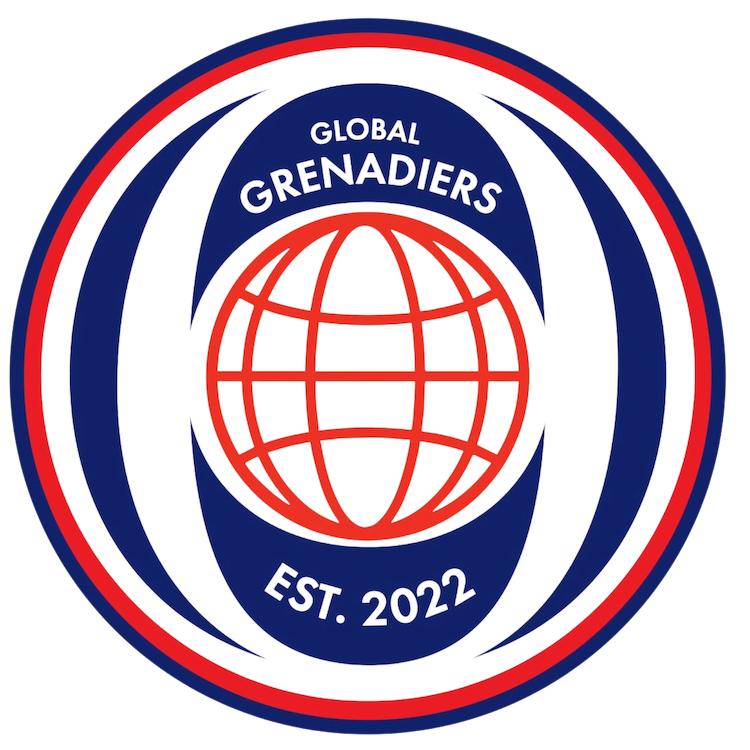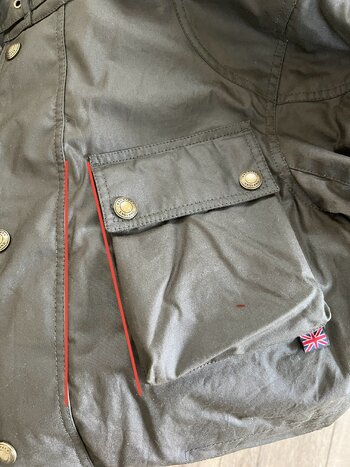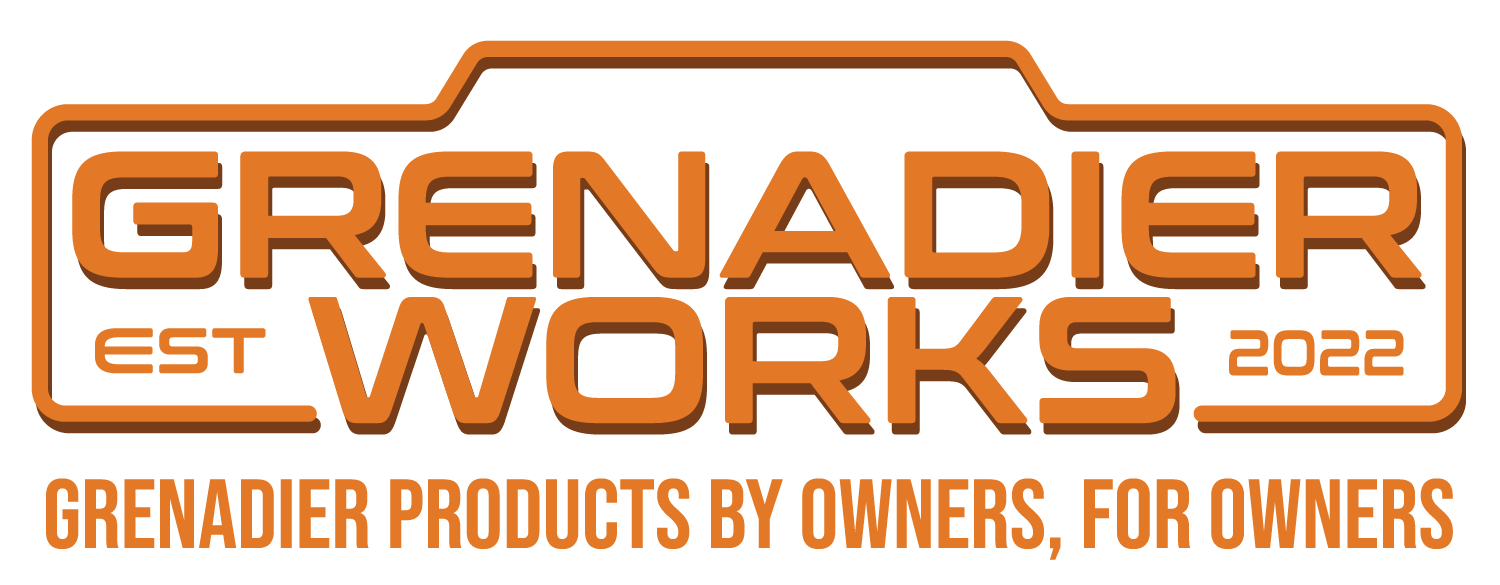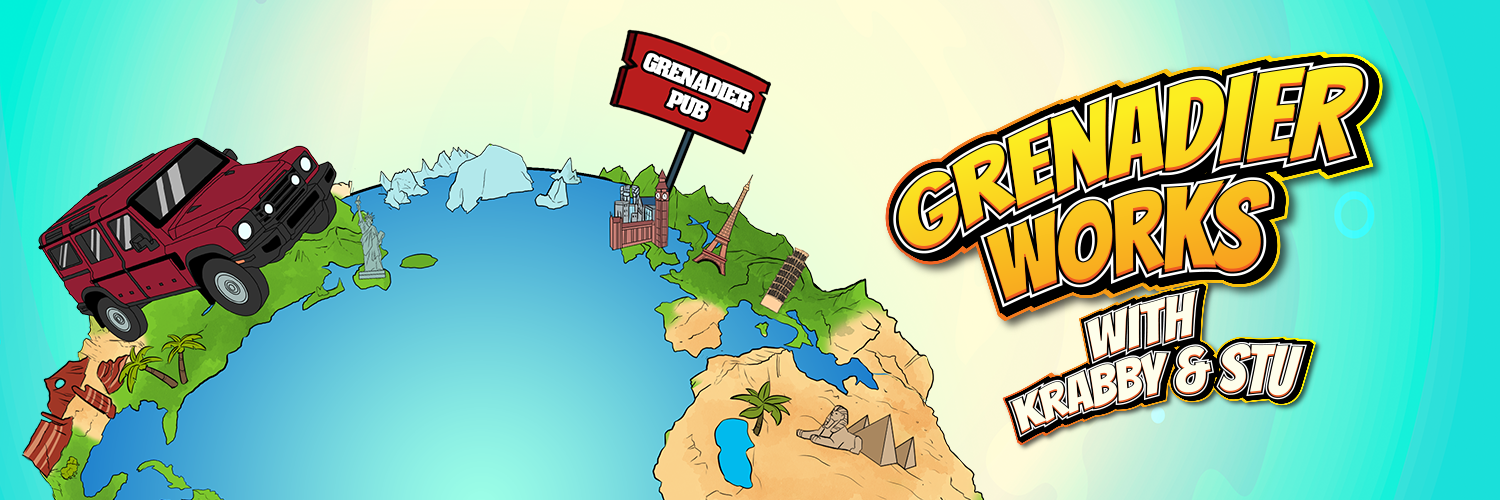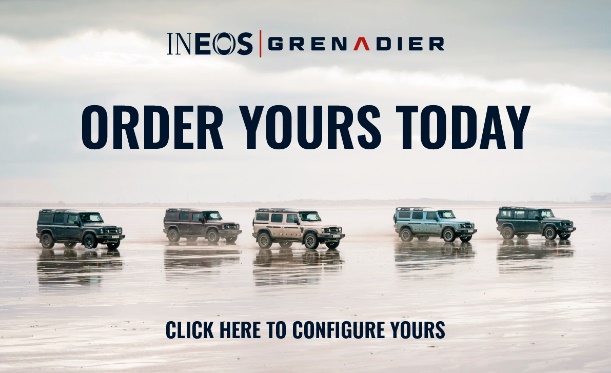I received mine, but screwed up the measurements, LOL. If I can lose about a hundred pounds, it just might fit...
The Grenadier Forum
Register a free account today to become a member! Once signed in, you'll be able to contribute to the community by adding your own topics, posts, and connect with other members through your own private inbox! INEOS Agents, Dealers or Commercial vendors please use the contact us link at the bottom of the page.
You are using an out of date browser. It may not display this or other websites correctly.
You should upgrade or use an alternative browser.
You should upgrade or use an alternative browser.
The Definitive Jacket thread.
- Thread starter Stu_Barnes
- Start date
-
- Tags
- belstaff jackets
Finally received mine. First time they sent the wrong size. Second time they sent the correct size (I ordered the same size both times).
It really is an awesome jacket and I am excited to finally have it. Even if it is 90+ summertime degrees...
I did order the Fieldmaster jacket (I like it better) even though I have a Trialmaster truck and thus have a Fieldmaster patch... if anyone wants to swap a Fieldmaster patch for a Trialmaster patch, or has a Trialmaster patch they don't want, please let me know.
It really is an awesome jacket and I am excited to finally have it. Even if it is 90+ summertime degrees...
I did order the Fieldmaster jacket (I like it better) even though I have a Trialmaster truck and thus have a Fieldmaster patch... if anyone wants to swap a Fieldmaster patch for a Trialmaster patch, or has a Trialmaster patch they don't want, please let me know.
He I received a jacket that is too small. Would you be interested in a swap? I'm in Dallas.Mine arrived today as well. I ordered a size 60 and it fits in the sleeves, shoulder and chest but damn…the rest fits me like a tent
If I ever wear it, I’ll definitely need a belt, haha
TBH, I don’t think a smaller size would fit me in the shoulders and arms….and I found that there are toggles inside the jacket to bring in the waist area. I’ve actually worn it during some pretty good storms.He I received a jacket that is too small. Would you be interested in a swap? I'm in Dallas.
INEOS will accept a return won’t they? Send yours back for the correct size
I successfully exchanged my fieldmaster jacket with a different size. I was trying it on and found an interesting quirk which i initially thought was a defect. After looking at pictures online, it seems that the top pocket with the British flag is slanted. Does anyone know the reason for this?
Attachments
- Local time
- 8:25 AM
- Joined
- May 19, 2022
- Messages
- 2,339
The angled position is designed to make it easier to insert maps. This should be a relief for motorcyclists.I successfully exchanged my fieldmaster jacket with a different size. I was trying it on and found an interesting quirk which i initially thought was a defect. After looking at pictures online, it seems that the top pocket with the British flag is slanted. Does anyone know the reason for this?
Last edited:
How did you get the process rolling? Mine is too small.Ineos customer service is providing a prepaid box for me to send back the very small jacket I received. They will send me a proper sized one.
Respond to the email saying your jacket shipped... let them know you need to exchange.How did you get the process rolling? Mine is too small.
You can email automotive.BelstaffJackets@ineos.comHow did you get the process rolling? Mine is too small.
@Krabby, I emailed automotive.belstaffjackets@ineos.com with "Belstaff jacket wrong size" in the subject line and explain to them what happened.How did you get the process rolling? Mine is too small.
Best of luck,
Greg
Today Belstaff was sold to Castore. Of course, because everything was totally fine, Ineos was so proud of Belstaff, it got better every year and now it gets even better, as Castore is great, ambitious, blablabla...
The official press release:
 www.ineos.com
www.ineos.com
AWo, counting 2 + 2
The official press release:
Castore completes the acquisition of Belstaff.
Premium brands Castore and Belstaff come together to drive further international growth. Castore acquires 100% of Belstaff, on a debt-free, cash-free basis. INEOS, the parent company of Belstaff, will make a significant strategic investment in Castore
AWo, counting 2 + 2
I am not sure i see the issue. Basically a merger of two British luxury brands and Ineos takes a large financial stake in the combined company. Win-win. No?Today Belstaff was sold to Castore. Of course, because everything was totally fine, Ineos was so proud of Belstaff, it got better every year and now it gets even better, as Castore is great, ambitious, blablabla...
The official press release:Castore completes the acquisition of Belstaff.
Premium brands Castore and Belstaff come together to drive further international growth. Castore acquires 100% of Belstaff, on a debt-free, cash-free basis. INEOS, the parent company of Belstaff, will make a significant strategic investment in Castorewww.ineos.com
AWo, counting 2 + 2
If the sale itself would standalone it would be not worth mentioning (Belstaff produced a 18 mio. loss in 2024). But look at the overall picture: chemical plants are closed and partnerships are cancelled, the chemical business in Europe faces the third of year of heavy losses, sports engagements are reverted or reduced (in football, cycling, F1, rugby, sailing), Grenadier sales are way from what was intended and needed. At the same time expensive investments, which started in normal times, put Ineos under further financial pressure like the purchase of a French plant in Lavera and the €4+ bn. cracker in Belgium, still under construction, as well as the new plants in China together with Sinopec. The talks between Ineos and Chery seems to be more about production capacity in Hambach than making a car together. Maybe Ineos will build Chery cars to get more capacity utilization to Hambach, to lower their own costs there.
AWo
AWo
“
Castore, the manufacturer of premium sports apparel, has today announced that it has agreed to acquire 100% of the shares of Belstaff, the British premium heritage brand, on a debt-free, cash-free basis. The deal, the financial terms of which are undisclosed, will see INEOS, parent company of Belstaff, make a significant strategic investment in Castore at a holding company level.”
I’m really far from a business man (and slept through Econ 15), but IA essentially is giving BS to Cas AND investing in them? If that is indeed the situation (that’s how it reads to me anyway), that seems odd. Why would the company invest in the company to whom they sold out to?
Castore, the manufacturer of premium sports apparel, has today announced that it has agreed to acquire 100% of the shares of Belstaff, the British premium heritage brand, on a debt-free, cash-free basis. The deal, the financial terms of which are undisclosed, will see INEOS, parent company of Belstaff, make a significant strategic investment in Castore at a holding company level.”
I’m really far from a business man (and slept through Econ 15), but IA essentially is giving BS to Cas AND investing in them? If that is indeed the situation (that’s how it reads to me anyway), that seems odd. Why would the company invest in the company to whom they sold out to?
Profits and losses mean little, cash flow means most. Any idea as to their cash flow in total or by subsidiary? They only thing I know is that my Belstaff jacket is really nice and my Trialmaster is great. Not sure I really care about the rearrangement of their assets.If the sale itself would standalone it would be not worth mentioning (Belstaff produced a 18 mio. loss in 2024). But look at the overall picture: chemical plants are closed and partnerships are cancelled, the chemical business in Europe faces the third of year of heavy losses, sports engagements are reverted or reduced (in football, cycling, F1, rugby, sailing), Grenadier sales are way from what was intended and needed. At the same time expensive investments, which started in normal times, put Ineos under further financial pressure like the purchase of a French plant in Lavera and the €4+ bn. cracker in Belgium, still under construction, as well as the new plants in China together with Sinopec. The talks between Ineos and Chery seems to be more about production capacity in Hambach than making a car together. Maybe Ineos will build Chery cars to get more capacity utilization to Hambach, to lower their own costs there.
AWo
Last edited:
lol who cares about an obscure British apparels brand? Literally have never heard of belstaff
In fairness to Belstaff, the brand is world reknowed in different circles and is the reason Ineos named it's signature Grenadier the Trialmaster. Some might need to venture out a bit more and get out from UnderDaRockies. 
Key Considerations for Both Parties“
Castore, the manufacturer of premium sports apparel, has today announced that it has agreed to acquire 100% of the shares of Belstaff, the British premium heritage brand, on a debt-free, cash-free basis. The deal, the financial terms of which are undisclosed, will see INEOS, parent company of Belstaff, make a significant strategic investment in Castore at a holding company level.”
I’m really far from a business man (and slept through Econ 15), but IA essentially is giving BS to Cas AND investing in them? If that is indeed the situation (that’s how it reads to me anyway), that seems odd. Why would the company invest in the company to whom they sold out to?
Clear Definitions:
Clearly define what constitutes "cash" and "debt" in the sale agreement to avoid disputes.
Negotiate Working Capital:
Agree on a benchmark level of net working capital that the business must maintain at closing.
Post-Sale Adjustments:
Include clauses in the purchase agreement for adjustments to the purchase price if the actual cash or working capital levels at closing deviate from the agreed-upon targets.
@Krabby
A "cash-free, debt-free" transaction is a deal structure where the purchase price is based on the value of the core business operations, with the seller retaining the company's excess cash and being responsible for paying off all existing debt before the sale closes. The buyer takes ownership of the business's operating assets and liabilities, but not its financial assets or liabilities. Both parties must agree on a target level of operating cash and a normal working capital level to ensure the business can operate smoothly after the sale.
How a Cash-Free, Debt-Free Deal Works
1. Enterprise Value vs. Equity Value:
The agreed-upon purchase price, or Enterprise Value, reflects the underlying value of the business itself, not its specific cash and debt levels.
2. Seller's Cash:
The seller is entitled to any cash above the "cash-free" level, which is a pre-determined amount of operating cash the buyer expects to remain in the business to fund day-to-day operations.
3. Seller's Debt:
The seller is responsible for paying off all outstanding debts of the company before the transaction closes.
Implications for the Seller
Retention of Excess Cash:
The seller keeps the "excess" cash not needed for the business's ongoing operations, increasing the final proceeds from the sale.
Responsibility for Debt:
The seller must pay off all loans and liabilities, including any penalties or fees associated with early repayment.
Working Capital Management:
The seller must ensure the business has enough cash to meet the agreed-upon working capital levels at closing, which includes inventory, receivables, and payables necessary for continued operations.
Implications for the Buyer
No Debt Assumption:
The buyer acquires the business free of financial debt, avoiding complex loan agreements and potential covenants.
No Excess Cash:
The buyer does not receive any "excess" cash beyond the agreed-upon operating cash, as this is considered part of the seller's proceeds.
Operational Liquidity:
The buyer receives the business with sufficient working capital to continue its operations seamlessly after the sale.
A "cash-free, debt-free" transaction is a deal structure where the purchase price is based on the value of the core business operations, with the seller retaining the company's excess cash and being responsible for paying off all existing debt before the sale closes. The buyer takes ownership of the business's operating assets and liabilities, but not its financial assets or liabilities. Both parties must agree on a target level of operating cash and a normal working capital level to ensure the business can operate smoothly after the sale.
How a Cash-Free, Debt-Free Deal Works
1. Enterprise Value vs. Equity Value:
The agreed-upon purchase price, or Enterprise Value, reflects the underlying value of the business itself, not its specific cash and debt levels.
2. Seller's Cash:
The seller is entitled to any cash above the "cash-free" level, which is a pre-determined amount of operating cash the buyer expects to remain in the business to fund day-to-day operations.
3. Seller's Debt:
The seller is responsible for paying off all outstanding debts of the company before the transaction closes.
Implications for the Seller
Retention of Excess Cash:
The seller keeps the "excess" cash not needed for the business's ongoing operations, increasing the final proceeds from the sale.
Responsibility for Debt:
The seller must pay off all loans and liabilities, including any penalties or fees associated with early repayment.
Working Capital Management:
The seller must ensure the business has enough cash to meet the agreed-upon working capital levels at closing, which includes inventory, receivables, and payables necessary for continued operations.
Implications for the Buyer
No Debt Assumption:
The buyer acquires the business free of financial debt, avoiding complex loan agreements and potential covenants.
No Excess Cash:
The buyer does not receive any "excess" cash beyond the agreed-upon operating cash, as this is considered part of the seller's proceeds.
Operational Liquidity:
The buyer receives the business with sufficient working capital to continue its operations seamlessly after the sale.
Similar threads
- Replies
- 1
- Views
- 193
- Replies
- 60
- Views
- 4K
- Replies
- 5
- Views
- 357
